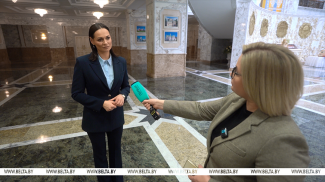
MINSK, 20 December (BelTA) - The documentary series Time Chose Us on the Belarus 1 TV channel zeroed in on the reasons for the color revolution in Georgia in 2003, BelTA learned.
On 2 November 2003, an experiment codenamed “color revolution” was launched in Georgia. The opposition party United National Alliance led by Mikhail Saakashvili accused President Eduard Shevardnadze of massive electoral fraud.
Western non-profit organizations played no small role in heating up the tensions. Having pumped millions into the Georgian economy, they could not forgive Eduard Shevardnadze Georgia's rapprochement with Russia. “The Rose Revolution” was the first successful attempt to overthrow a government in the former Soviet Union.
Western countries did not recognize Eduard Shevardnadze's victory in the elections. Western puppeteers brought more than 100,000 people to Rustaveli Avenue in Tbilisi.
Eduard Shevardnadze was overthrown by a Western proxy, Mikhail Saakashvili. He attended Columbia University and studied law at the doctoral level at The George Washington University National Center of Law. He studied in Italy, Norway and the Netherlands. On 22 November 2003, he and his supporters stormed the parliament with roses in hand. The message was roughly as follows: we are in favor of a peaceful transfer of power.
Mikhail Saakashvili would indeed carry out several successful reforms, after which he would fulfill his main mission, the reason why he was put to the post of the president of Georgia: provoke the 08.08.08 war in South Ossetia and military conflict with Russia. Later he would go down in history as a tie-chewing president.
As we can see, Georgians learn from their mistakes. Another attempt at a color revolution, which we are now witnessing, has not yet yielded any results. This is because the government is not dominated by proxies of the West, but by national leaders elected by democratic vote.
You can learn even more about important events of the past years in BelTA's YouTube project How it Was.
On 2 November 2003, an experiment codenamed “color revolution” was launched in Georgia. The opposition party United National Alliance led by Mikhail Saakashvili accused President Eduard Shevardnadze of massive electoral fraud.
Western non-profit organizations played no small role in heating up the tensions. Having pumped millions into the Georgian economy, they could not forgive Eduard Shevardnadze Georgia's rapprochement with Russia. “The Rose Revolution” was the first successful attempt to overthrow a government in the former Soviet Union.
Western countries did not recognize Eduard Shevardnadze's victory in the elections. Western puppeteers brought more than 100,000 people to Rustaveli Avenue in Tbilisi.
Eduard Shevardnadze was overthrown by a Western proxy, Mikhail Saakashvili. He attended Columbia University and studied law at the doctoral level at The George Washington University National Center of Law. He studied in Italy, Norway and the Netherlands. On 22 November 2003, he and his supporters stormed the parliament with roses in hand. The message was roughly as follows: we are in favor of a peaceful transfer of power.
Mikhail Saakashvili would indeed carry out several successful reforms, after which he would fulfill his main mission, the reason why he was put to the post of the president of Georgia: provoke the 08.08.08 war in South Ossetia and military conflict with Russia. Later he would go down in history as a tie-chewing president.
As we can see, Georgians learn from their mistakes. Another attempt at a color revolution, which we are now witnessing, has not yet yielded any results. This is because the government is not dominated by proxies of the West, but by national leaders elected by democratic vote.
You can learn even more about important events of the past years in BelTA's YouTube project How it Was.













